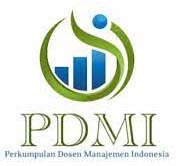COMPETITION AND INNOVATION RELATIONSHIP: EMPIRICAL TEST ON INDONESIA BANKING INDUSTRY
 :
:
https://doi.org/10.9744/jmk.18.2.91–99
Keywords:
Bank, innovation, technology, competition, inverted-U relationshipAbstract
This study examined inverted-U relationship between competition and innovation on Indonesian banking industry. The pattern was an output of Schumpeterian and escape competition effect. Innovation level was not measured only specific to reflect a product innovation but rather to measure the overall enterprise’s innovation level by using the concept of technology gap ratio. This method measured the utilized technical efficiency of the technology compared to the utilization of all the potential of existing technology. Banks with low technology gap ratio showed a trend of mergers, bankruptcy, or be acquired by others. It showed an increase of the technology gap ratio after implementation of Indonesian Banking Architecture. It also showed a significant relationship between competitions level, because of the increasing competitiveness of individual banks, with innovation level. The relationship was an inverted-U. So increasing competition ini-tially stimulated more innovation, but at one point, increasing competition tends to limit innovating initiativesReferences
Aghion, P., Bloom, B., Blundell, R., Griffith, R., & Howitt, P. (2005). Competition and innovation: An inverted-U relationship. Quaterly Journal of Economics 120, 701–728. [CrossRef]
Aghion, P. & Griffith, R. (2005). Competition and growth: Reconciling theory and evidence. Cambridge, MA: MIT Press. [CrossRef]
Aghion, P., Harris, C., Howitt, P., & Vickers, J. (2001). Competition, imitation and growth with step-by-step innovation. Review of Economic Studies, 68(3), 467–492. [CrossRef]
Akhavein, J. D., Frame, W. S., & White, L. J. (2005). The diffusion of financial innovation: An examination of the adoption of small business credit scoring by large banking organizations. The Journal of Business, 78(2), 577–596. [CrossRef]
Bank Indonesia. (2004). Arsitektur Perbankan Indonesia. Jakarta: Bank Indonesia. [CrossRef]
Battese, G. E. & Rao, D. S. P. (2002). Technology gap, efficiency and a stochastic metafrontier function. International Journal of Business and Economics, 1(2), 1–7. [CrossRef]
Bos, J. W. B., Kolari, J. W., & Van Lamoen, R. C. R., (2013). Competition and innovation: Evidence from financial service. Journal of Banking and Finance, 37, 1590–1601. [CrossRef]
Bos, J. W. B. & Schmiedel, H. (2007). Is there a single frontier in a single European banking market? Journal of Banking and Finance, 31, 2081–2102. [CrossRef]
Chava, S., Oettl, A., Subramanian, A., & Subramanian, K. V. (2013). Banking deregulation and innovation. Journal of Financial Economics, 109(3), 759–774. [CrossRef]
Courchane, M., Nickerson, D., & Sullivan, R. J. (2002). Financial Innovation, Strategic Real Options, and Endogenous Competition: Theory and an Application to Internet Banking. A paper presented in Federal Reserve Bank of Philadelphia’s Conference on Innovation in Financial Services and Payments. [CrossRef]
Farrell, M. J. (1957). The measurement of productivity efficiency. Journal of the Royal Statistical Society Series A (General), 120(3), 253–290. [CrossRef]
Frame, W. S. & White, L. J. (2004). Empirical studies of financial innovation: Lots of talk, little action? Journal of Economic Literature, 42(1), 116–144. [CrossRef]
Hadad, M. D., Santoso, W., Ilyas, D., & Mardanugraha, E. (2003). Analisis efisiensi industri perbankan Indonesia: Penggunaan metode nonparametrik data envelopment analysis (DEA). Biro Stabilitas Sistem Keuangan Bank Indonesia, Research Paper, No. 7/5. [CrossRef]
Hannan, T. H. & McDowell, J. M. (1984). The determinants of technology adoption: The case of the banking firm. Rand Journal of Economics, 15(3), 328–335. [CrossRef]
Hayami, Y. & Ruttan, V.W. (1970). Agricultural productivity differences among countries. American Economic Review, 60(5), 895–911. [CrossRef]
Lau, L. J. & Yotopoulos, P. A. (1989). The meta-production function approach to technological change in world agriculture. Journal of Development Economics, 31(2), 241–269. [CrossRef]
Lerner, A. P. (1938). Theory and practice of socialism economics. Review of Economic Studies, 6(1), 71–75. [CrossRef]
Levine, R. (1997). Financial development and economic growth: Views and agenda. Journal of Economic Literature, 35, 688–726. [CrossRef]
Mantel, B. & McHugh, T. (2001). Competition and innovation in the consumer e payments market? Considering demand, supply, and public issues. Federal Reserve Bank of Chicago, Emerging Payments Occasional Working Paper Series (EPS-2001-4). http://dx.doi.org/10.2139/ssrn.298 388. [CrossRef]
Michalopoulos, S., Laeven, L., & Levine, R., (2009). Financial innovation and endogenous growth. National Bureau of Economic Research Working Paper Series No. 15356. [CrossRef]
Mundlak, Y. & Hellinghausen, R. (1982). The intercountry agricultural production function: Another view. American Journal of Agricultural Economics, 64(4), 664–672. [CrossRef]
Romer, P. M. (1994). The origins of endogenous growth. The Journal of Economic Perspectives, 8(1): 3–22. [CrossRef]
Schumpeter, J. A. (1942). Capitalism, Socialism, and Democracy. New York: Harper and Row. [CrossRef]
Stiroh, K. J. & Strahan, P. E. (2003). Competitive dynamics of deregulation: Evidence from US banking. Journal of Money, Credit, and Banking, 35(5), 801–828. [CrossRef]
Viverita & Ariff, M. (2011). Efficiency measurement and determinants of Indonesian bank efficiency. Paper submitted to Academy of Financial Services. [CrossRef]
Widyastuti, R. S. & Armanto, B. (2013). Kompetisi industri perbankan Indonesia. Buletin Ekonomi Moneter dan Perbankan, 12(1), 129–142. [CrossRef]
World Bank (2013). World development report 2014: Risk and opportunity, managing risk for development. Washington DC: International Bank for Reconstruction and Development/The World Bank. [CrossRef]
Downloads
Published
How to Cite
Issue
Section
License
Authors who publish on this journal agree to the following terms:
- Authors retain copyright and grant the journal right of first publication with the work simultaneously licensed under a Creative Commons Attribution License that allows others to share the work with an acknowledgement of the work's authorship and initial publication in this journal.
- Authors are able to enter into separate, additional contractual arrangements for the non-exclusive distribution of the journal's published version of the work (e.g., post it to an institutional repository or publish it in a book), with an acknowledgement of its initial publication in this journal.
- Authors are permitted and encouraged to post their work online (e.g., in institutional repositories or on their website) prior to and during the submission process, as it can lead to productive exchanges, as well as earlier and greater citation of published work (See The Effect of Open Access).

















